Corpuscularia lehmannii
Corpuscularia lehmannii (Eckl. & Zeyh.) Schwantes
Family: Aizoaceae
Common names: Coega hardfig
Introduction
Corpuscalaria lehmannii, commonly known as the Coega hardfig, is a compact, perennial succulent belonging to the Aizoaceae family. It is a slow to moderate growing plant and is long-lived under suitable conditions, thriving for many years in both natural habitats and cultivated settings. With its structural leaves and resilience under harsh conditions, it features well as a sculptural plant in gardens.
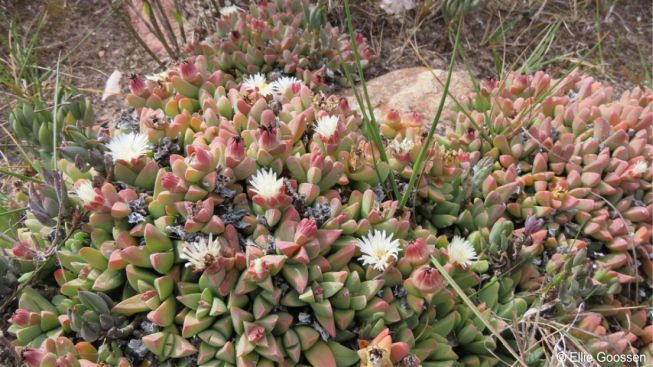
Description
Description
Corpuscularia lehmannii typically forms low, spreading clumps that reach 100–200 mm in height and can spread to about 300 mm in diameter. Its growth habit is somewhat shrubby, with a densely packed, angular appearance due to its thick, opposite, and distinctly 3-angled (trigonous) leaves. The stems are short, stout, and often partially hidden by the clustered leaves. They are fleshy, becoming somewhat woody at the base with age, and may take on a greyish-green tone. The bark on older stems can become corky and brownish, providing a slight contrast to the younger green stems. The plant often branches from the base, leading to a bushy or sprawling form. Branches are relatively short and upright to decumbent, depending on age and growing conditions.
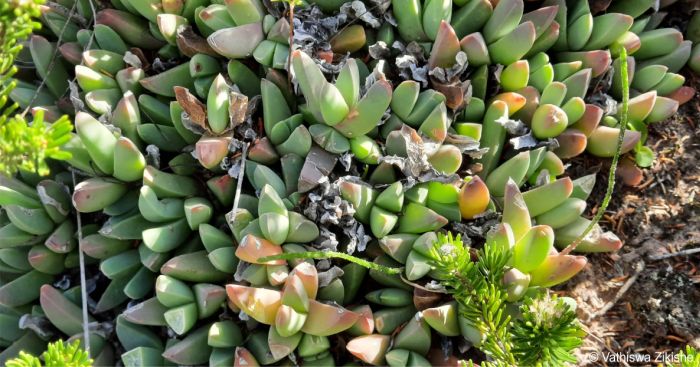
The leaves of Corpuscularia lehmanni are its most notable feature: thick, smooth, triangular in cross-section, and arranged in opposite pairs. They are grey-green to bluish-green, with a waxy coating that helps reduce water loss. The leaf pairs are often slightly incurved and measure about 20–40 mm long and up to 15 mm wide. The margins are often lined with small, translucent water cells that help the plant tolerate dry conditions.
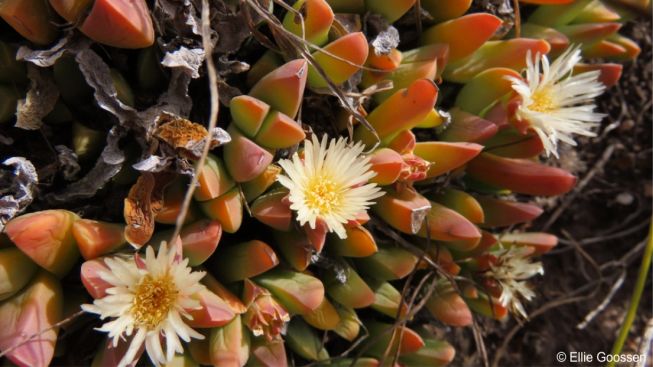
Inflorescences arise singly from the stem tips or leaf axils, usually bearing a single typical, daisy-like mesemb flower. The flowers comprise numerous slender petals, shading from white to cream to pale yellow, radiating from the yellow centre, about 30–40 mm in diameter. The flowering period typically ranges from late spring to early autumn (November to April), although it can vary slightly depending on climate and growing conditions. The fruit is a small capsule that develops after flowering. These fruits open when wet, a common trait shared by many species in the Aizoaceae. Each capsule contains several tiny, rounded to slightly angular, brown seeds that are dispersed by rain, an adaptation to their arid native environment.
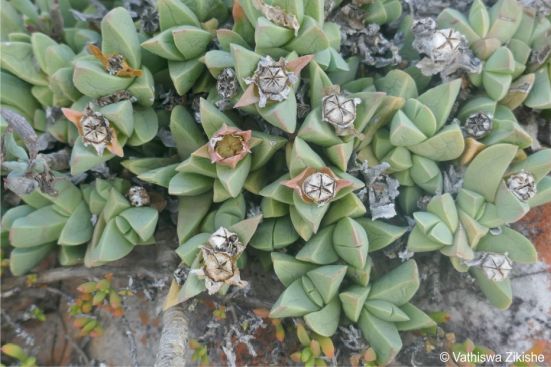
Conservation Status
Status
Corpuscularia lehmannii is currently assessed as Critically Endangered (CR) in the Red List of South African Plants. This species is known from just 6 locations and is threatened by invasive alien species, habitat loss, pollution and habitat degradation. The ongoing urban development and habitat degradation have led to local extinctions of 4 of the subpopulations. The remaining populations are now highly fragmented and continue to decline.
Distribution and habitat
Distribution description
The Coega hardfig is native and endemic to South Africa, only found growing in the Eastern Cape province. This plant is historically recorded growing along the coastal plain from Coega to Gqeberha (Port Elizabeth), as well as near Uitenage, Alicedale, and other parts of the Albany Division in the Eastern Cape. It grows on quartzite or quartz-rich outcrops and rocky, well-drained slopes. It is often seen in rock crevices where soil accumulates. This species thrives in karroid vegetation, the semi-arid shrubland typical of the Eastern Cape’s inland zones. Additionally, it is found growing in transitional zones such as Albany Thicket and Fynbos-Renosterveld.
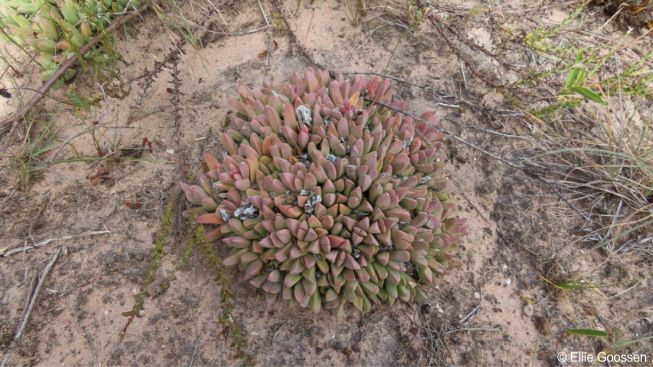
Derivation of name and historical aspects
History
The genus name Corpuscularia is derived from the Latin corpusculum meaning ‘little body’, with the suffix -aria denoting possession or connection, thus the complete name means ‘with or belonging to small bodies’. This refers to the plant’s compact, plump leaves. The specific epithet lehmannii honours Johann Georg Christian Lehmann (1792–1860), a German botanist and professor in Hamburg, recognized for founding the Hamburg Botanical Garden and his contributions to botanical science.
The species Corpuscularia lehmannii was first described as Mesembryanthemum lehmannii in 1837 by botanists Christian Friedrich Ecklon and Carl Ludwig Philipp Zeyher in Enumeratio Plantarum Africae Australis extratropicae, acknowledging the species for the first time scientifically. In 1926, the species was reassigned to the genus Corpuscularia by Gustav Schwantes, published in Zeitschrift für Sukkulentenkunde, affirming its current generic placement. Later on, the species was shuffled through other classifications: Schonlandia lehmanni in 1927 by L. Bolus, and Delosperma lehmannii in 1949 by H. Jacobsen. However, Corpuscularia lehmannii remains the accepted name, although some scientific authorities recognise the synonym Delosperma lehmannii.
The genus Corpuscularia is a small group of succulent plants belonging to the Aizoaceae (commonly known as the vygie family in southern Africa), a family with 135 genera and about 1 800 species. This genus comprises 8 species: C. angustifolia, C. angustipetala, C. appressa, C. britteniae, C. cymbiformis, C. gracillima, C. lehmannii and C. taylori, characterized by either densely tufted, fleshy leaves or elongated stems with noticeable internodes. These plants are distinguished by their firm, xeromorphic leaves, which feature a uniform epidermal cell type and lack bladder cells or other idioblasts.
Ecology
Ecology
The flowers of Corpuscularia lehmannii attract general pollinators, most often bees, that are drawn to sunny, open karroid slopes. The xeromorphic epidermis, helps plants in minimising water loss – an adaptation to their arid karroid habitats. The leaves of C. lehmannii usually shrink when dehydrated, serving as a natural indicator for water need. Similar to other mesembs, Coega hardfig produces hygrochastic capsules that open when wet, allowing rainfall to wash the tiny angular seeds out of the capsules and disperse them into crevices.
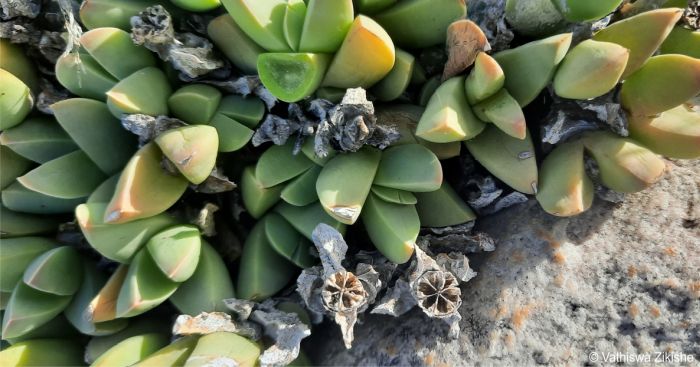
Uses
Use
The Coega hardfig can be used as a decorative houseplant with its unusual sculptural appearance. Additionally, it is an ideal plant to be given as small potted succulent plant in events like conferences, weddings, etc. Other than its aesthetic and ornamental features, there are no studies or reports that document any medicinal or cultural uses of the species C. lehmannii.
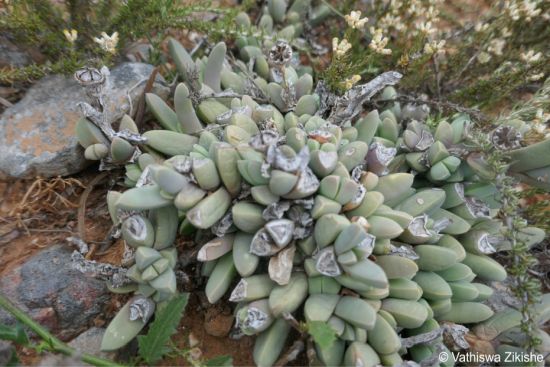
Growing Corpuscularia lehmannii
Grow
Corpuscularia lehmannii can be propagated using either seeds or cuttings. Though, stem cuttings are often preferred since it produces a larger plant quicker than propagation by seeds, as seedlings are slow growing.
Seed sowing is ideally done in mid-spring to early summer, while plants are actively growing. Use seedling trays and growth medium suitable for germinating succulents, such as a mix containing fine river sand (60–70%) and sifted compost (30–40%), which is often used at Karoo Desert National Botanical Garden. With the drainage of germination trays supported by coarse particles such as bark, crushed stones etc. at the base, fill trays with growth medium and moisten it. Scatter seeds evenly on the growth medium surface and then add a thin layer of fine river sand to anchor the seeds and prevent them from moving over. The layer should be minimal to allow sunlight to reach the seeds, since it is needed for germinating Coega hardfig. Place the trays inside the greenhouse receiving indirect sunlight, with a temperature ranging between 21–26°C. Then water seed trays on a daily basis using a misting sprayer, until they germinate. Where germination is practiced at home, trays can be gently watered and then sealed with plastic to retain moisture until seeds germinate, with regular misting when needed. Germination of C. lehmanni can be achieved in the first 2–4 weeks after sowing. When seedlings are established, gradually expose them to more light and airflow before transplanting, until they can withstand direct sunlight. Hardened off seedlings can be transplanted directly to the garden or in suitable pots using potting mix suitable for succulent plants.
Stem cuttings of C. lehmanni are best done in mid-spring to summer as well. It is always ideal to use sterilised equipment and healthy material for cuttings to achieve best results, i.e. secateurs, seedling trays, growth media, rooting hormone (optional) and healthy plant material. Take cuttings early in the morning, while the plant hormones are active. To further prevent pathogens from affecting cuttings, let cuttings dry for about 2 days in a dry, clean area to allow the cut end to callus, preventing rot. Then dip the callused end in semi-hardwood or hardwood rooting hormone to encourage faster root development. Insert the cut end into moist, well-draining succulent potting mix. Place the cuttings trays in a warm production house receiving indirect sunlight and water them with mist sprayer. Keep the trays moist and not wet, since air circulation is also critical for rooting while damp growth media invite pathogens. Once cuttings have rooted, transplant to a bigger container and harden off from two weeks after transplanting. Hardening off can be done following similar procedures as for hardening off seedlings.
The Coega hardfig looks great when cultivated as a pot plant, located indoors at a sunny spot receiving indirect sunlight and free airflow. Use nice ornamental pots for indoors, growing it with a well-draining succulent potting mix (2 parts coarse sand, 1 part fine compost, 1 part crushed granite). Ensure that the soil pH is neutral to slightly acidic (6.0–7.0). This plant demands minimal watering, however, it is ideal to provide moderate watering when planted indoors to prevent it from shrinking when is underwatered. Outside, this species is suitable for dry, rocky gardens designed for low maintenance. Grow the Coega hardfig in mild, dry climates, in full sun to partial shade. The soil should be well-draining and with moderate to low water-holding capacity. Water the plant well but infrequently during spring and summer, and water sparingly in autumn and winter (dormant season) – ideally once every two weeks to a month.
This species, together with other related species, often suffer from root rot caused by overwatering and poor drainage – which should be avoided at all times. Common pests such as mealybugs, aphids and spider mites may take a chance on the Coega hardfig. Treat such with insecticidal soap or neem oil; where only a few scouted on the plants, manual removal is advised. To prevent the plant from hosting pests, often remove dead or damaged parts from the plant.
References
- Botanical Realm. Hardfigs (Corpuscularia). https://www.botanicalrealm.com/plant-identification/hardfigs-corpuscularia/. Accessed 28 June 2025.
- Bredenkamp, C.L. 2019. A flora of the Eastern Cape Province, Volume 1. Strelitzia 41. SANBI, Pretoria.
- Frith. 1923. Herbarium specimen of Corpuscularia lehmannii. Royal Botanic Gardens Kew Herbarium. Available at JSTOR Global Plants. https://plants.jstor.org/stable/10.5555/al.ap.specimen.k001044482.
- Hartmann, H. 2001. Illustrated handbook of succulent plants. Aizoaceae, A-E. Springer, Berlin.
- Llifle. The Encyclopedia of Succulents. Corpuscularia lehmannii (Eckl. & Zeyh.) Schwantes. https://llifle.com/Encyclopedia/SUCCULENTS/Family/Aizoaceae/27710/Corpuscularia_lehmannii. Accessed 1 July 2025.
- Manning, J. & Goldblatt, P. 2012. Plants of the Greater Cape Floristic Region 1: the Core Cape Flora. Strelitzia 29. South African National Biodiversity Institute, Pretoria.
- Plantin. Corpuscularia lehmannii Care. https://myplantin.com/plant/911?. Accessed 29 June 2025.
- Plants of the World Online. Corpuscularia lehmannii (Eckl. & Zeyh.) Schwantes. https://powo.science.kew.org/taxon/urn%3Alsid%3Aipni.org%3Anames%3A361375-1. Accessed 28 June 2025.
- POSA Plants of southern Africa online. Corpuscularia search. https://posa.sanbi.org/sanbi/Explore. Accessed 24 July 2025.
- Raimondo, D. & Helme, N.A. 2006. Corpuscularia lehmannii (Eckl. & Zeyh.) Schwantes. National Assessment: Red List of South African Plants. https://redlist.sanbi.org/species.php?species=5297-3.
- Smith, G.F., Chesselet, P., Van Jaarsveld, E.J., Hartmann, H., Hammer, S., Van Wyk, B-E., Burgoyne, P., Klak, C. & Kurzweil, H. 1998. Mesembs of the world. Briza, Pretoria.
- Succulent City. 2024. Corpuscularia lehmannii (Delosperma lehmannii) – The ‘Ice Plant’ Succulent. https://succulentcity.com/corpuscularia-lehmannii/. Accessed 28 June 2025
- Succulents and Sunshine. Corpuscularia lehmannii. https://www.succulentsandsunshine.com/types-of-succulents/corpuscularia-lehmannii-ice-plant/. Accessed 29 June 2025.
- WFO The World Flora Online. Corpuscularia lehmannii (Eckl. & Zeyh.) Schwantes. http://www.worldfloraonline.org/taxon/wfo-0000621762. Accessed 26 June 2025.
- World of Succulents. Corpuscularia lehmannii (Ice Plant). https://worldofsucculents.com/corpuscularia-lehmannii-ice-plant. Accessed 28 June 2025.
Credits
Thabang Makola
Karoo Desert National Botanical Garden
July 2025
Acknowledgements: the author thanks Vathiswa Zikishe and Ellie Goossen for providing images of Corpuscularia lehmannii.
Plant Attributes:
Plant Type: Succulent
SA Distribution: Eastern Cape
Soil type: Sandy, Loam
Flowering season: Early Summer, Late Summer
PH: Acid, Neutral
Flower colour: White, Pink, Yellow
Aspect: Full Sun
Gardening skill: Easy
Special Features:
Horticultural zones
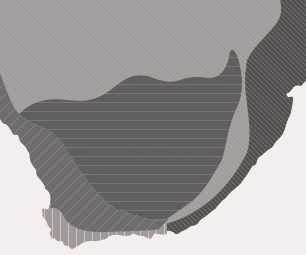






Rate this article
Article well written and informative
Rate this plant
Is this an interesting plant?
Login to add your Comment
Back to topNot registered yet? Click here to register.